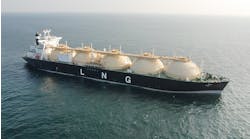Reservoir productivity, gas re-injection dictate new drilling strategies for Hibernia
The massive Hibernia gravity base structure (GBS) in the North Atlantic Ocean is an important technological achievement in the history of the industry. Beyond the pre-engineering design of the GBS itself and the unique technical challenges of platform installation, one of the greatest hurdles the project organizers faced from the beginning was developing a workforce capable of high-tech, large-scale operations
An organized project team was in place one year before the first well was drilled to address this initial challenge. Today, Hibernia Management and Development Company Ltd. (HMDC) emphasizes local training and education to increase the technical knowledge base of the work force.
With limited infrastructure available for initial project planning and development, an integrated management approach was selected by the operator. A team of experienced owner company personnel drew on existing Newfoundland and Canadian expertise along with Schlumberger's Integrated Project Management (IPM) services to assist in the well construction portion of the project. The reported major advantage of using a service such as IPM has been "interface efficiency" between multiple teams and operations functions.
The strategy appears to have worked well in this large and unique "startup" scenario. The close involvement of service providers with operating management teams has created a highly qualified workforce, comprised of 83% Newfoundlanders, 10% other Canadians, and the remaining 7% expatriates from other parts of the world. Other evidence of a growing industry workforce is the participation by Newfoundland-based companies in oil industry activities around the world. Expertise created in the Hibernia Development has allowed local companies to expand into markets elsewhere.
Reservoir longevity
Short-term successes and challenges have brought the Hibernia project to a turning point-design plateau production. Now, long-term success will depend on a smooth transition from managing startup economics, to managing cost economics. A more detailed long-term management plan is being developed through inputs from an extensive data acquisition program.
"The challenge in both the near and long term will be keeping the topsides busy, supplying and processing at maximum efficiency," explains Debbs Nelson, Hibernia Well Performance Team Leader.
The reservoir is highly compartmentalized, with each fault block treated as an individual reservoir. Initial indications imply minimal to no fluid communication across fault blocks, a fact confirmed by downhole pressure gages in producing wells. Therefore, a producer and injector will be drilled and brought on line for most blocks.
Reservoir development
The Hibernia reservoir is proving to contain clean, highly productive, oil-saturated sands, compartmentalized into multiple blocks. The productivity of the reservoir has been above expectations in certain areas of the field. This pro duction capability has allowed reservoir and drilling engineers to use 7-in. diameter production tubing. This allows high deliverability and the means to exploit the reservoir's productivity. Also, the added space inside this larger tubing provides more flexibility in future intervention operations.
The Hibernia reservoir does not appear to require multi-lateral well technologies for the current development plan. Productivity indications of wells drilled to date imply that these expensive well technologies would not enhance production enough to justify the cost of their use.
There is, however, a consensus among drilling and reservoir engineers that "multi-target" wells will be beneficial, capitalizing on the reservoir's high production capability. These multi-target wells will generate potential opportunities to use intelligent completions.
Compartmentalization
The compartmentalized nature of the Hibernia sands has dictated reservoir management philosophy from the beginning of the project. Twelve wells have been drilled and completed to date: six producers and six injectors. At this point in the development plan, each well is critical to the overall project productivity.
Reservoir compartmentalization requires accurate pressure measurements to optimize each block's depletion program. This has been accomplished through the application of remote formation testing. Wireline logging runs have been reduced by combining multiple wireline technologies and the use of real-time LWD measurements. Correlation of Schlumberger's ISONIC LWD tool with wireline nuclear porosity measurements has been so good, that the decision has been made to run the tool in the intermediate hole section as the only porosity measurement in this part of the well. Production hole drilling has employed a range of LWD measurements including a Quad combo.
The use of non-conductive, synthetic muds has limited ability to image the wellbore while drilling. This will no longer be a problem with an improved Azimuthal Density Neutrontrademark tool, capable of 16-quadrant density and photoelectric effect (PE) imaging. This technology will be used during the construction phase of the next extended reach well.
The addition of Schlumberger's new ARC6 induction resistivity tool in the fourth quarter of this year will provide while-drilling, real-time, and time-lapsed solutions to interpreting invasion profiles in the highly prolific Hibernia reservoir.
Big bore completions
Completion procedures have been designed to allow for inner-string liner cementing techniques, saving valuable rig time." The technique allows the well to be displaced to completion fluid immediately after cementing, saving one trip," explains Brian Stacey, Senior Drilling Engineer, Schlumberger IPM.
"This technique is used to prevent cement from contacting the production liner by passing cement through an inner string and out the bottom of the liner. This eliminates the need for running a casing scraper inside the liner. The result is a cleaner completion, and in the case of chrome liners, which Hibernia has deployed, there is a corrosion prevention advantage as well," he explained.
Current production will be raised and maintained at levels so as to maximize topside facilities utilization. The anticipated life of the GBS is 30 years, raising the question of what to do once initial production levels begin to drop off. "Marginal fields could be brought on line once production decline commences," stated Harvey Smith, President of HMDC. "Most of these fields will require a pipeline tieback to the Hibernia platform." Subsea pumping and heating/insulating technologies will be put to the test in the near freezing ocean temperatures.
Glory holes
By the time these questions have to be addressed, the glory hole technology of the Terra Nova project will have been evaluated, and can provide insight into the alternatives to be pursued. "Some encouraging outcomes from the first two years of operation have been the Hibernia reservoir's production capability, well construction advancements that allow exploitation of this increased productivity, and our capability to operate safely in a harsh environment," Smith said.
The first two years of operation have shown that the platform can operate with minimal lost time accidents and minimal environmental impact. Also, other projects offshore Newfoundland will impact Hibernia. "Shared support services will be a key area for cost management," Smith said. "The sharing of onshore facilities and services will benefit all companies involved."
The biggest potential for extending the Hibernia platform's production life will be in the development of the Avalon reservoir. Initial recovery estimates are about 5% of the hydrocarbons in place. Reprocessing of Avalon seismic data along with the 2000 Avalon drilling and evaluation program will help define the producibility of this complex reservoir.


